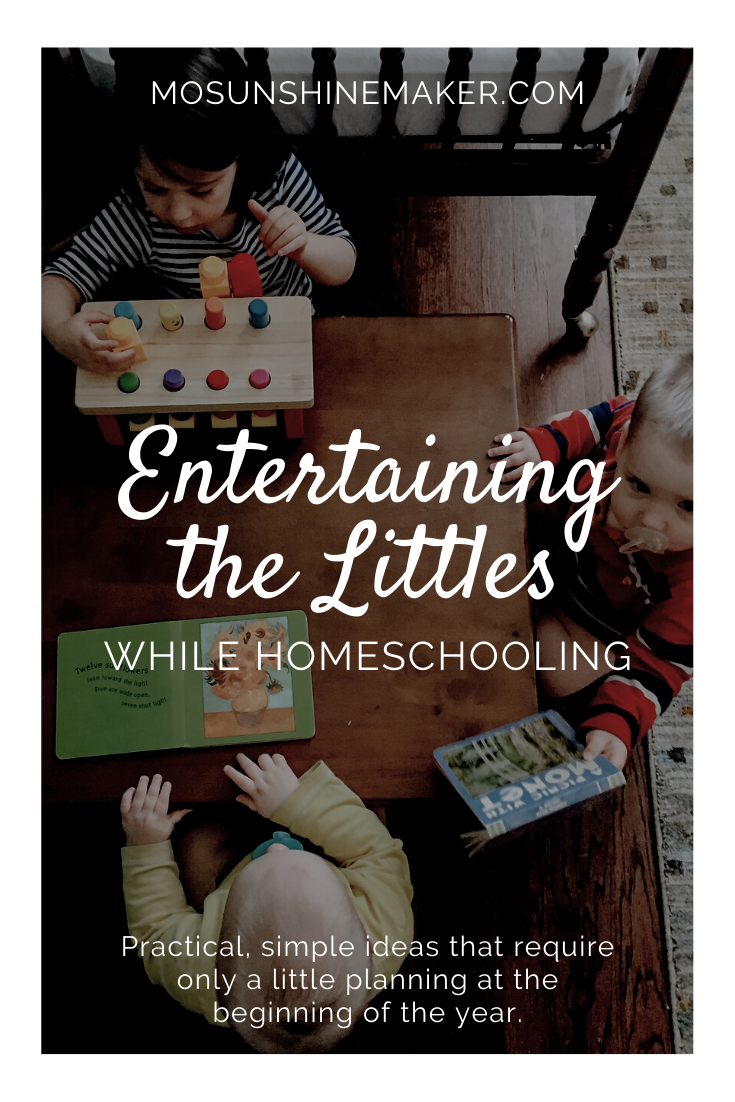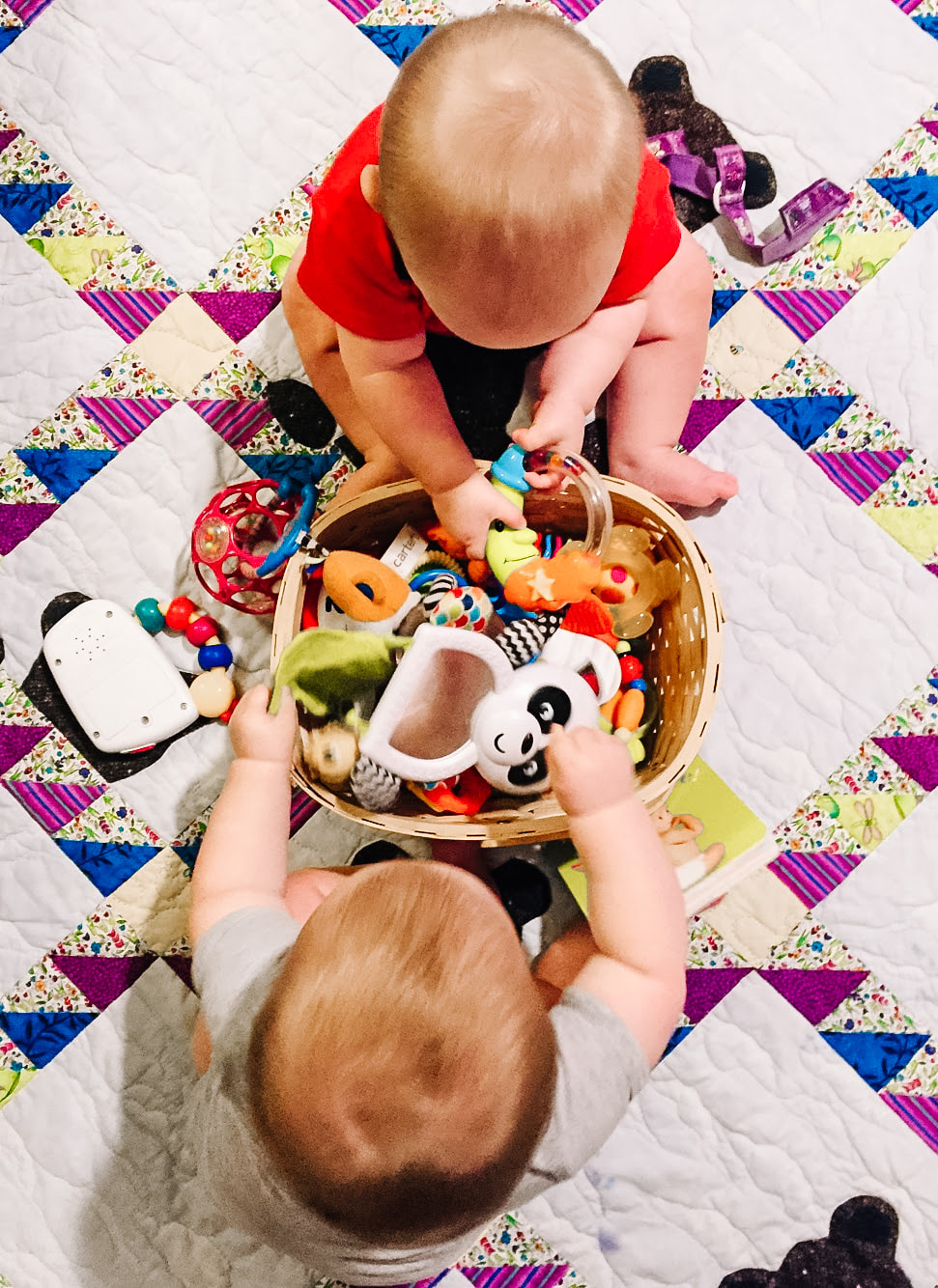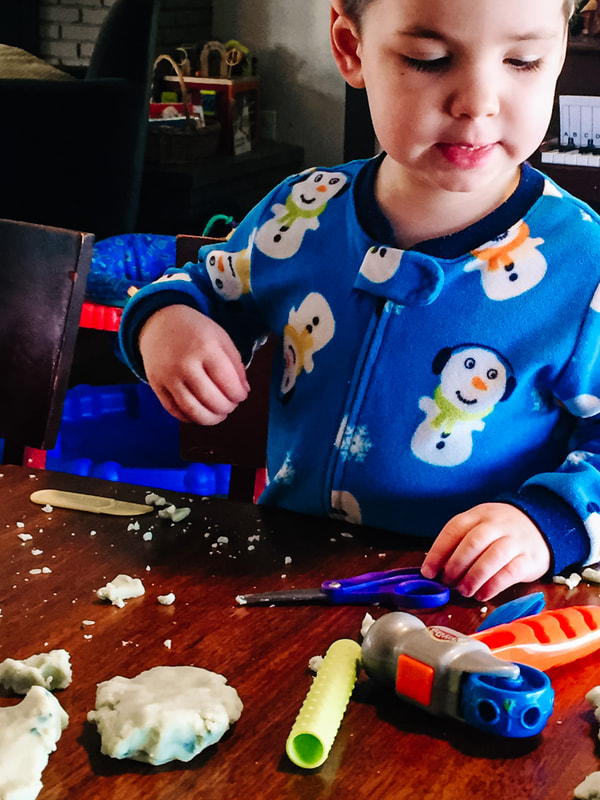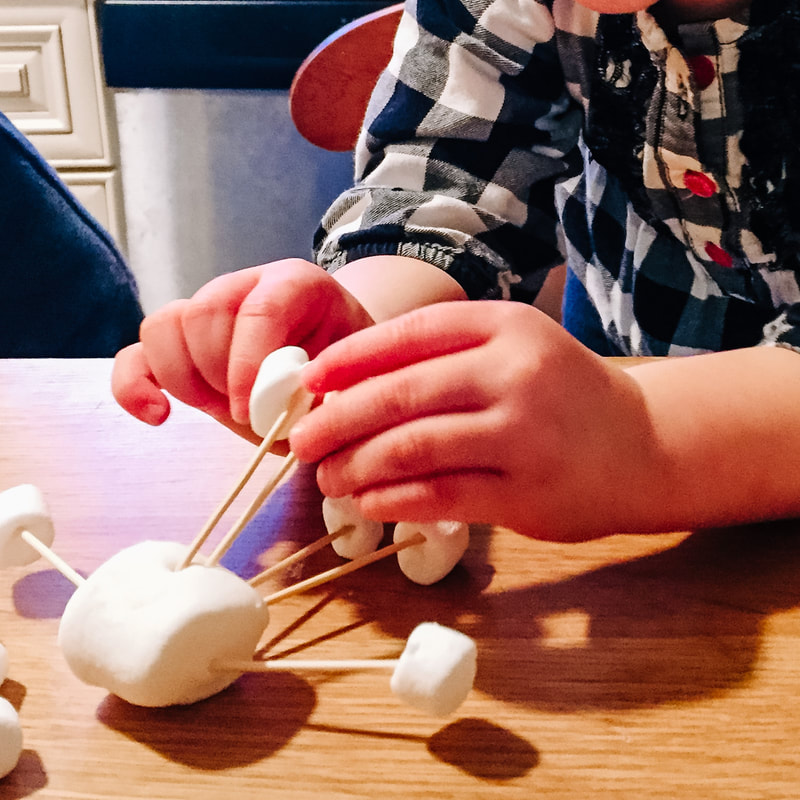|
Homeschooling has been a huge blessing for our family. When my Little twins were born, my older twins were only 20 months old - I had four children under two, along with a four year old and a 2nd grader. In the beginning, I was recovering from a C-section and spent about a quarter of my day nursing babies. We took several weeks off school because of this but before long, we needed the rhythm of school to give our day some order and I knew I had to re-figure out my management techniques. So, when I say that this wisdom has been hard-won and learned in the trenches, you’ll see what I mean. These tips are practical, simple, and require only a little planning at the beginning of the year. You CAN occupy your little ones while teaching your older ones. Begin School Time by Reading Together This past year, I really enjoyed starting our school day by piling everyone on the couch and reading a picture book together. This concept is sometimes called “morning time” and can also involve any other whole-group activity - Bible lesson, singing, memorization etc. The point is that the younger ones get included, too. They want to be just like their older siblings! There are several reasons why starting school with reading has worked out so well. All my kids love being read to. They don’t groan about starting school if I’m just saying, “Hey, let’s sit down and read this book!” And, honestly, reading puts me in a calmer state of mind. I’ve usually just gotten done chasing kids down for diaper changes, yelling out last minute reminders about chores, or throwing another load of laundry on. So, it’s a bit exhausting to think about starting school by giving out more directions. Instead, I sit down and don’t have to think about what to say, I relax and read the words already written down! Also, this book, whether fiction or nonfiction, is usually chosen by me and relates to something one of the Bigs are learning. The whole family gets to learn about a topic together with a picture book. Sometimes, this reading time can become a bit contentious when all of them want to turn the page/sit on mom’s lap/cuddle under the blanket, but reading aloud to children has so many benefits. Reading great literature to my kids (there are lots of amazing picture books on every topic!) exposes them to many facets of the world and starts great conversations. Order of Operations: The Youngest First After we read together, we break off into separate activities, but I always start with the youngest - they aren’t capable of waiting yet. If you have itty-bitty babies, this means that diapers and feedings come first. Fit in quality time with them by playing peek-a-boo while you change them; talk about their body parts as you dress them. When you need to attend to the baby, give them your full attention so they get a good share of your time. A contented baby will mean a smoother school time for everyone else. From there, I put the Littles in their cribs with some toys and board books to have some independent time. Before they were crawling, I put them on a blanket with a basket of toys. Bonus: this is teaching them to play on their own! It also usually turned into their morning nap time. If you’re trying to drop the morning nap, put them in a pack ‘n play in the room with you. Next, I move my slightly-older, two-year old middles into an activity. I select from a handful of different not-very-messy activities or a special toy (more on this in a minute). They love having their own toddler table for their project, but sometimes they also like to be at the main table with the Bigs. I want them to know that they are important during school time, too, but the goal is to give them enough attention and then leave them busy. Then, I begin to do actual school work with the Bigs, still beginning with the youngest - this year, that was my kindergartner, William. Since he isn’t reading yet, there isn’t much he can do by himself, but kindergarten does not take long. In fact, the sit-down-at-the-table time was only about 30 minutes for us once we got into a groove (we had additional activities that we saved for later because Peter usually wanted to participate, too). That leaves Peter (eight) until the end - this is also character development for him. He learns patience, how to take initiative and how to be self-motivated. After a couple weeks, he knows which subjects he can get started by himself, and I usually let him do them in the order he likes. One important change I made during the year is that we would go over his math lesson together, but he did the workbook pages the next day during his independent time. Finding activities for your preschooler(s) I’m greatly indebted to Pinterest for a lot of the things I’ve learned as a mom. But, there is a rabbit hole to avoid: sensory activities for your preschooler/toddler. Those types of activities (You’ve seen them: they involve finger paints, tubs of water, sand, and food coloring) have their place. You can do those when your little one has your full attention. The activities that I pick to occupy my preschoolers during homeschool time need to be as independent and fool-proof as possible. Pinterest can still be helpful here - just be discerning as to what you can handle during lessons. Check out my board for realistic ideas. Don’t pick messy activities I selected a rotation of only-slightly-messy projects: a tray of dried beans, playdough, watercolors, sticker sheets, and safety scissors with old magazines. You can make an item more interesting each week by pairing it with something new. For example, give them dinosaurs with the playdough (show them how to make footprints!) or let them put stickers on a paper towel roll. The activity needed to be very interesting, but not very hard to clean up. I made a big deal about keeping the beans/playdough/etc. off the floor and my two-and-a-half year olds were able to mostly do it. If they start to make messes, it meant they were getting bored (it was almost always Daniel!), so I would put it away immediately. Give one toy at a time It’s a fact: toys are more interesting when the children can’t have them all the time. Our family has acquired several types of blocks - duplo legos, megablocks, magna tiles, and wooden blocks. I keep each one in a separate tub and out of reach. Then, I bring them out one at a time, primarily when I need the kids to be occupied (like during school or dinner-prep); it’s like I gave them a brand new toy! Other toys that can work this way are small world play sets such as a farm with animals or a house with people/furniture. Since they don’t have access to these toys all the time, they keep their novelty. Side note: this even works for older kids with toy sets that have too many pieces. We have a marble run toy that drives me crazy because the parts and little marbles get scattered everywhere, but the Bigs love to build with it when it is only available occasionally. If I keep five tubs of toys put away, the Middles are so excited to have access to them once a week. Hungry kids are grumpy kids
Be sure to have snack time (even the older kids will be happier) and make it an event for the younger ones. This is especially easy with babies buckled into a high chair with a large tray - it’s really the only time I would be okay with doing a messy activity (even better if you have a dog to clean up any mess that makes it to the floor). I strip the baby down to their diaper and give them a pile of food to eat, I mean, play with! Yogurt, pudding, cooked noodles, jello, hummus… be creative! Keep a damp cloth nearby to wipe them down afterwards. Snack time for preschoolers can be a fun fine-motor activity. Try letting them string cheerios, build with toothpicks and grapes (or marshmallows), cut shapes into a slice of cheese with a butter knife, or sort gummy fruit snacks/animal crackers/fruit loops into groups. The big kids get jealous Sometimes the Bigs want to play with what the Middles have. Snack time can be difficult because they all eat the same thing, but I don’t want the Bigs to spend time playing until they are finished with school. So, I use this as an incentive to finish more quickly: “If you finish your math lesson early, then you can have 5 minutes to make a cheerio necklace, too.” Growing up is hard! Maybe I need a cheerio necklace break... Don’t dismiss free-play Planned activities help keep an important daily rhythm for your children, but be sure to give the little ones plenty of free-play time, too. If you can give them time outside, even better! For extra gross-motor play one winter, I found a small toddler slide that fit in our school room. During free-play, my kids turned it into a fort, mountain, cave, house, ship, and more! The play that it inspired was amazing and I didn't have to facilitate anything! Also, see my Part Two post with specific plans for how I’ll be “entertaining” my Middles and Littles for the coming year. I’ll also get into a tiny bit about my early education philosophy. If you have any comments or questions about keeping your young ones occupied during school time, please feel free to comment below!
2 Comments
Julie
8/10/2020 12:29:37 pm
Susan, you’re such an inspiration to me. You always have been, but especially now that you’re sharing more about your day to day life. I was fighting (And dreading) full time homeschooling because I felt it was going to be almost impossible with 5 kids ranging from 8 years to 2 months, but reading your last 2 posts about homeschooling has been so encouraging and helpful. Thanks for taking the time to write this blog!
Reply
8/10/2020 02:16:03 pm
Thank you so much - that's so encouraging to hear! You are an amazing mom, but I understand how overwhelming it is. I'm so glad these posts have helped!
Reply
Your comment will be posted after it is approved.
Leave a Reply. |
AuthorSusan is a mother of six: five boys and one sweet girl. She is probably busy right now diapering a child, getting someone a snack, and looking for a lost shoe. Now, where is that coffee cup? Archives
October 2020
Categories
All
|





 RSS Feed
RSS Feed